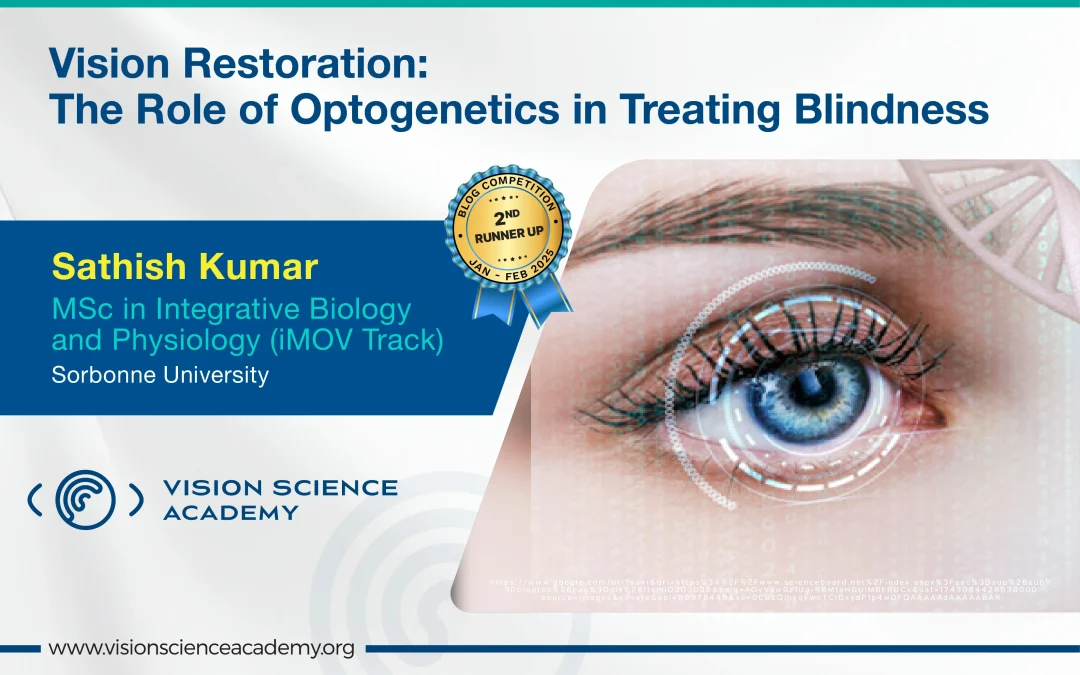Sathish Kumar S, B.Optom.
MSc in Integrative Biology and Physiology (iMOV Track), Sorbonne University, Paris, France
According to the 2020 Global Burden of Disease study, approximately 43.3 million people worldwide are affected by blindness, with 553 million living with some form of vision impairment. (1) These numbers highlight the growing concern of vision loss, which not only impacts individual’s quality of life but also poses significant health and economic challenges globally. Many conditions contribute to vision impairment, such as macular degeneration, glaucoma, cataracts, diabetes, and refractive errors, particularly in older adults. Additionally, inherited retinal disorders can lead to irreversible vision loss, and currently, no cure exists for these conditions.
Inherited retinal diseases often begin with the degeneration of photoreceptors, which are crucial for processing visual information. This process typically starts with the loss of rod photoreceptors, followed by the degeneration of cone outer segments. As the disease progresses, cone degeneration leads to structural changes in the retina, ultimately resulting in permanent vision loss.
Recent advancements in vision restoration offer hope for those affected by such conditions. Gene therapy has become the primary treatment for inherited retinal diseases, but the presence of multiple mutations in these diseases presents significant challenges. Traditionally, assistive devices have been the primary tool to aid people with severe vision loss, allowing them to perform daily activities. However, innovative approaches, including cell transplantation, visual prosthetics, and optogenetic therapy, are emerging as potential treatments for blindness.
Optogenetics has transformed the field of neurobiology by enabling the precise control of cells with light. The technique involves genetically modifying cells to make them responsive to light, like how fluorescent proteins emit light when exposed to certain wavelengths. (2) In optogenetics, blue light is used to activate channel rhodopsin (ChR2), a protein that plays a key role in the phototransduction process. Upon exposure to blue light, ChR2 opens and allows sodium ions to enter the cell, triggering neural responses that can lead to visual perception. (3)
In addition to ChR2, there are other optogenetic activators, such as halo rhodopsin, melanopsin, and engineered photo switches, which can be designed to target specific ion channels. To deliver optogenetic treatment, a vector carrying the genetic material is introduced into retinal cells via a method called adeno-associated virus (AAV) vector delivery. Once these genes are activated by light stimulation, they can trigger neural signals that are transmitted to the brain, enabling visual processing. (4)
Ganglion cells are considered the ideal target for optogenetic treatments. These cells are relatively accessible, and when channel rhodopsin is expressed in them, they can restore visual responses in animal models, such as blind mice.(3,4) The use of intravitreal injection, which delivers the vector directly into the eye, makes this procedure more efficient and less invasive. Researchers have also begun exploring the use of red light to activate the ChrimsonR channel, an alternative to blue light for stimulation. The effectiveness of optogenetic therapy depends on several factors, including the dose of the vector and the intensity of the light used. (4)
To evaluate the success of optogenetic treatment, tools like GCaMP6 calcium indicators and voltage indicators are used to measure retinal activity. These indicators allow researchers to observe the retinal response to external light stimulation, providing valuable insights into the functional improvements of the damaged retina.
In recent clinical trials, optogenetic therapy has shown promising results. A study involving a blind patient demonstrated partial restoration of visual function following optogenetic treatment. (5) In an experiment designed to test the effectiveness of the therapy, a tumbler was placed on a table, and the patient was asked to identify it with and without optogenetic stimulation. When the stimulation was applied, the patient was able to correctly identify the object, providing evidence that optogenetics could potentially restore visual perception in individuals who are blind.
These advancements in optogenetic therapy bring us closer to a future where vision loss due to inherited retinal diseases can be treated, offering new hope for individuals affected by blindness.
Reference:
- Lim, Z. W., Chee, M. L., Soh, Z. D., Majithia, S., Sahil, T., Tan, S. T., Sabanayagam, C., Wong, T. Y., Cheng, C. Y., & Tham, Y. C. (2023). Six-Year Incidence of Visual Impairment in a Multiethnic Asian Population: The Singapore Epidemiology of Eye Diseases Study. Ophthalmology science, 3(4), 100392. https://doi.org/10.1016/j.xops.2023.100392
- Gauvain, G., Akolkar, H., Chaffiol, A., Arcizet, F., Khoei, M. A., Desrosiers, M., Jaillard, C., Caplette, R., Marre, O., Bertin, S., Fovet, C. M., Demilly, J., Forster, V., Brazhnikova, E., Hantraye, P., Pouget, P., Douar, A., Pruneau, D., Chavas, J., Sahel, J. A., … Picaud, S. (2021). Optogenetic therapy: high spatiotemporal resolution and pattern discrimination compatible with vision restoration in non-human primates. Communications biology, 4(1), 125. https://doi.org/10.1038/s42003-020-01594-w
- Berling, D., Baroni, L., Chaffiol, A., Gauvain, G., Picaud, S., & Antolík, J. (2024). Optogenetic Stimulation Recruits Cortical Neurons in a Morphology-Dependent Manner. The Journal of neuroscience : the official journal of the Society for Neuroscience, 44(49), e1215242024. https://doi.org/10.1523/JNEUROSCI.1215-24.2024
- Chaffiol, A., Provansal, M., Joffrois, C., Blaize, K., Labernede, G., Goulet, R., Burban, E., Brazhnikova, E., Duebel, J., Pouget, P., Sahel, J. A., Picaud, S., Arcizet, F., & Gauvain, G. (2021). In vivo optogenetic stimulation of the primate retina activates the visual cortex after long-term transduction. Molecular therapy. Methods & clinical development, 24, 1–10. https://doi.org/10.1016/j.omtm.2021.11.009
- Sahel, JA., Boulanger-Scemama, E., Pagot, C. et al. Partial recovery of visual function in a blind patient after optogenetic therapy. Nat Med 27, 1223–1229 (2021). https://doi.org/10.1038/s41591-021-01351-4


Recent Comments